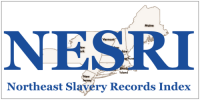In 1800 two-thirds of the NY State Senators and one-third of the NY State Assembly members were enslavers. This helps to explain why the best Gradual Abolition law Governor John Jay could negotiate did not actually free any current slaves, only their newborn children, but only after they had served their mother’s enslaver for 25-28 years. Slavery would be abolished, but in the distant future.
Today, in many NY Senate and Assembly districts, there are projects to acknowledge and research local histories of slavery. To assist legislators and constituents in these efforts, the Northeast Slavery Records Index (NESRI) provides, online at no charge, localized summaries of slavery records that help to illuminate the extent and details of enslavement in each locale. The reports can include census records, slave trade transactions, cemetery records, birth certifications, manumissions, ship inventories, newspaper accounts and advertisements, private narratives, legal documents and many other sources. The Northeast Slavery Records Index (NESRI) is a project of John Jay College of Criminal Justice and CUNY, in which students and faculty discover and index records of slavery from across the state and, with our partners, across the northeast. Below is an online form to instantly generate a report.
- Select NY as the state.
- Enter a county.
- Enter a town or city, or leave this blank and see the entire county.
When you press “enter” you will see a customized report.
The online report is organized in six sections with information customized for the locality you selected. The information is updated whenever we add records to our database, which happens frequently as more records are discovered.
- General introduction to the types of enslavement records available.
- Presentation of numerical census records – total numbers of free and enslaved people at various times.
- Presentations listing individual enslavers and the people they enslaved. Records of enslaved persons may include their names, and point to additional records documenting events in their lives. Records of enslavers practically always include their names, and point to additional records that document the numbers of people they enslaved and events like purchases, sales, and emancipations.
- Presentations listing enslaved people who enlisted and fought, on both the American and the British sides, in the Revolutionary War.
- Presentations of additional information about this place such as homes and buildings where enslavement took place, and information about resistance such as the underground railroad.
- A Topical Search section, permitting further online search and analysis of slavery records in the locality.
NESRI also includes articles of potential interest to legislators and their constituents.
- Slavery and the NY State Legislature – Identifies members of the legislature who were enslavers from 1790-1820.
- Dating the Beginning and End of Slavery in New York – Examines when slavery started and ended in NY.
- The Art of Enslavement – Identifies artworks depicting enslaved people and their enslavers.
- Slavery and the Family of John Jay – Traces the history of slavery, and the record of advocacy for reform, by members of the Jay family.
- Birth registrations and Abandonments – Identifies registrations of children born to enslaved mothers, claiming decades of service by the newborns.
- Religious Institutions and Enslavement – Described how older religious institutions can examine historical slavery in their organizations and sites.
- The Public Administration of Slavery – Describes the role of public officials in facilitating and resisting slavery.
- Names Index for Enslaved People – Search for enslaved people by first name.
For further information or comments contact the NESRI Co-Directors, Professor Ned Benton – nbenton@jjay.cuny.edu – and Professor Judy-Lynne Peters – jlpeters@jjay.cuny.edu.



